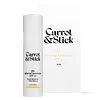What's inside
What's inside
 Key Ingredients
Key Ingredients

 Benefits
Benefits

 Concerns
Concerns

 Ingredients Side-by-side
Ingredients Side-by-side

Titanium Dioxide 4%
Cosmetic ColorantZinc Oxide
Cosmetic ColorantWater
Skin ConditioningEthylhexyl Palmitate
EmollientHelianthus Annuus Seed Oil
EmollientDimethicone
EmollientLauryl Methicone
Skin ConditioningPropanediol
SolventAleurites Moluccanus Seed Oil
Skin ConditioningLimnanthes Alba Seed Oil
Skin ConditioningArgania Spinosa Kernel Oil
EmollientAllantoin
Skin ConditioningAloe Barbadensis Leaf Extract
EmollientCucumis Sativus Fruit Extract
EmollientCamellia Sinensis Leaf Extract
AntimicrobialChamomilla Recutita Flower Extract
MaskingCitrus Grandis Peel Oil
MaskingCI 77492
Cosmetic ColorantSodium Hyaluronate
HumectantTocopheryl Acetate
AntioxidantTetrahexyldecyl Ascorbate
AntioxidantEthylhexylglycerin
Skin ConditioningPhenoxyethanol
PreservativeSodium Chloride
MaskingTitanium Dioxide 4%, Zinc Oxide, Water, Ethylhexyl Palmitate, Helianthus Annuus Seed Oil, Dimethicone, Lauryl Methicone, Propanediol, Aleurites Moluccanus Seed Oil, Limnanthes Alba Seed Oil, Argania Spinosa Kernel Oil, Allantoin, Aloe Barbadensis Leaf Extract, Cucumis Sativus Fruit Extract, Camellia Sinensis Leaf Extract, Chamomilla Recutita Flower Extract, Citrus Grandis Peel Oil, CI 77492, Sodium Hyaluronate, Tocopheryl Acetate, Tetrahexyldecyl Ascorbate, Ethylhexylglycerin, Phenoxyethanol, Sodium Chloride
Butyl Methoxydibenzoylmethane 2.3%
UV AbsorberHomosalate 10%
Skin ConditioningEthylhexyl Salicylate 5%
UV AbsorberOctocrylene 5%
UV AbsorberTrisiloxane
Skin ConditioningWater
Skin ConditioningDiisopropyl Sebacate
EmollientSilica
AbrasiveGlycerin
HumectantAlcohol Denat.
AntimicrobialIsododecane
EmollientPEG/PPG-9/2 Dimethyl Ether
Skin ConditioningLauryl PEG-9 Polydimethylsiloxyethyl Dimethicone
Skin ConditioningTrimethylsiloxysilicate
EmollientDextrin Palmitate
EmulsifyingDisteardimonium Hectorite
StabilisingTrehalose
HumectantPEG-9 Polydimethylsiloxyethyl Dimethicone
EmulsifyingPhytosteryl Macadamiate
Skin ConditioningSodium Chloride
Masking2-O-Ethyl Ascorbic Acid
Skin ConditioningAminoethanesulfinic Acid
AntioxidantDipotassium Glycyrrhizate
HumectantPanthenyl Ethyl Ether
Sodium Polyacrylate
AbsorbentTocopheryl Acetate
AntioxidantSodium Hyaluronate
HumectantSanguisorba Officinalis Root Extract
CleansingCamellia Sinensis Leaf Extract
AntimicrobialGarcinia Mangostana Bark Extract
Skin ConditioningPerilla Ocymoides Leaf Extract
TonicSpirulina Platensis Extract
Skin ProtectingDimethylacrylamide/Sodium Acryloyldimethyltaurate Crosspolymer
Butylene Glycol
HumectantSilica Dimethyl Silylate
EmollientTrisodium EDTA
Tocopherol
AntioxidantBHT
AntioxidantAlcohol
AntimicrobialSodium Metabisulfite
AntioxidantRosmarinus Officinalis Leaf Extract
AntimicrobialCI 77120
Cosmetic ColorantSodium Citrate
BufferingPhenoxyethanol
PreservativeParfum
MaskingButyl Methoxydibenzoylmethane 2.3%, Homosalate 10%, Ethylhexyl Salicylate 5%, Octocrylene 5%, Trisiloxane, Water, Diisopropyl Sebacate, Silica, Glycerin, Alcohol Denat., Isododecane, PEG/PPG-9/2 Dimethyl Ether, Lauryl PEG-9 Polydimethylsiloxyethyl Dimethicone, Trimethylsiloxysilicate, Dextrin Palmitate, Disteardimonium Hectorite, Trehalose, PEG-9 Polydimethylsiloxyethyl Dimethicone, Phytosteryl Macadamiate, Sodium Chloride, 2-O-Ethyl Ascorbic Acid, Aminoethanesulfinic Acid, Dipotassium Glycyrrhizate, Panthenyl Ethyl Ether, Sodium Polyacrylate, Tocopheryl Acetate, Sodium Hyaluronate, Sanguisorba Officinalis Root Extract, Camellia Sinensis Leaf Extract, Garcinia Mangostana Bark Extract, Perilla Ocymoides Leaf Extract, Spirulina Platensis Extract, Dimethylacrylamide/Sodium Acryloyldimethyltaurate Crosspolymer, Butylene Glycol, Silica Dimethyl Silylate, Trisodium EDTA, Tocopherol, BHT, Alcohol, Sodium Metabisulfite, Rosmarinus Officinalis Leaf Extract, CI 77120, Sodium Citrate, Phenoxyethanol, Parfum
 Reviews
Reviews

Ingredients Explained
These ingredients are found in both products.
Ingredients higher up in an ingredient list are typically present in a larger amount.
Camellia Sinensis Leaf Extract is derived from the leaves of the tea plant. Black tea, green tea, and oolong tea are all harvested from this plant.
This ingredient has many skin benefits:
This ingredient contains polyphenols, a strong antioxidant. Antioxidants help fight off molecules that damage skin cells.
On top of that, the antioxidants in green tea neutralize free-radicals from the sun. This gives the skin some extra UV protection, but should not replace sunscreen.
Many components of tea have anti-inflammatory properties.
Polyphenols and L-theanine help soothe the skin and reduce irritation. The caffeine in Camellia Sinensis Leaf Extract helps calm inflamed blood vessels.
Other compounds found in tea include: Vitamin Bs, linoleic acid, magnesium, calcium, iron, and zinc.
Research has shown both drinking Camellia Sinensis Leaf Tea and applying it to the skin can help boost skin elasticity and hydration. Studies also show using tea extract may reduce sebum, or oil, production.
Learn more about Camellia Sinensis Leaf ExtractPhenoxyethanol is a preservative that has germicide, antimicrobial, and aromatic properties. Studies show that phenoxyethanol can prevent microbial growth. By itself, it has a scent that is similar to that of a rose.
It's often used in formulations along with Caprylyl Glycol to preserve the shelf life of products.
Chances are, you eat sodium chloride every day. Sodium Chloride is also known as table salt.
This ingredient has many purposes in skincare: thickener, emulsifier, and exfoliator.
You'll most likely find this ingredient in cleansers where it is used to create a gel-like texture. As an emulsifier, it also prevents ingredients from separating.
There is much debate on whether this ingredient is comedogenic. The short answer - comedogenic ratings don't tell the whole story. Learn more about comegodenic ratings here.
The concensus about this ingredient causing acne seems to be divided. Research is needed to understand if this ingredient does cause acne.
Scrubs may use salt as the primary exfoliating ingredient.
Learn more about Sodium ChlorideSodium Hyaluronate is hyaluronic acid's salt form. It is commonly derived from the sodium salt of hyaluronic acid.
Like hyaluronic acid, it is great at holding water and acts as a humectant. This makes it a great skin hydrating ingredient.
Sodium Hyaluronate is naturally occurring in our bodies and is mostly found in eye fluid and joints.
These are some other common types of Hyaluronic Acid:
Learn more about Sodium HyaluronateTocopheryl Acetate is AKA Vitamin E. It is an antioxidant and protects your skin from free radicals. Free radicals damage the skin by breaking down collagen.
One study found using Tocopheryl Acetate with Vitamin C decreased the number of sunburned cells.
Tocopheryl Acetate is commonly found in both skincare and dietary supplements.
Learn more about Tocopheryl AcetateWater. It's the most common cosmetic ingredient of all. You'll usually see it at the top of ingredient lists, meaning that it makes up the largest part of the product.
So why is it so popular? Water most often acts as a solvent - this means that it helps dissolve other ingredients into the formulation.
You'll also recognize water as that liquid we all need to stay alive. If you see this, drink a glass of water. Stay hydrated!
Learn more about Water